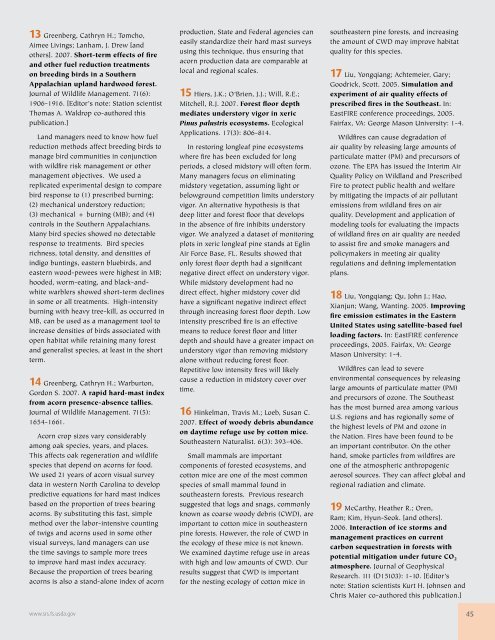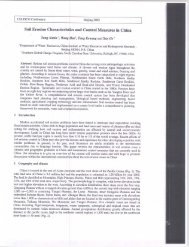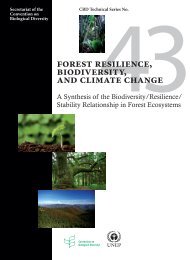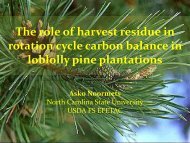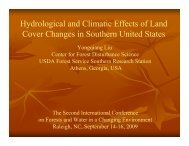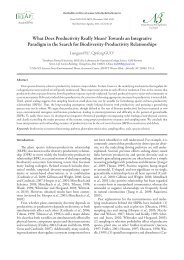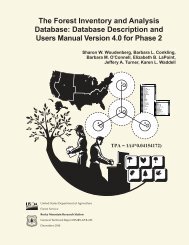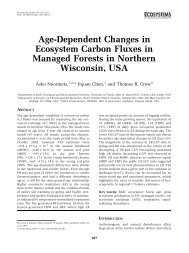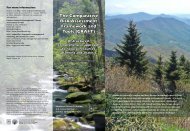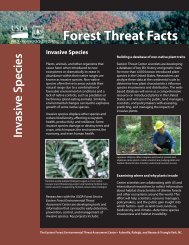What do forests have to do with global climate change? What do ...
What do forests have to do with global climate change? What do ...
What do forests have to do with global climate change? What do ...
Create successful ePaper yourself
Turn your PDF publications into a flip-book with our unique Google optimized e-Paper software.
13 Greenberg, Cathryn H.; Tomcho,<br />
Aimee Livings; Lanham, J. Drew [and<br />
others]. 2007. Short-term effects of fire<br />
and other fuel reduction treatments<br />
on breeding birds in a Southern<br />
Appalachian upland hardwood forest.<br />
Journal of Wildlife Management. 71(6):<br />
1906-1916. [Edi<strong>to</strong>r’s note: Station scientist<br />
Thomas A. Waldrop co-authored this<br />
publication.]<br />
Land managers need <strong>to</strong> know how fuel<br />
reduction methods affect breeding birds <strong>to</strong><br />
manage bird communities in conjunction<br />
<strong>with</strong> wildfire risk management or other<br />
management objectives. We used a<br />
replicated experimental design <strong>to</strong> compare<br />
bird response <strong>to</strong> (1) prescribed burning;<br />
(2) mechanical unders<strong>to</strong>ry reduction;<br />
(3) mechanical + burning (MB); and (4)<br />
controls in the Southern Appalachians.<br />
Many bird species showed no detectable<br />
response <strong>to</strong> treatments. Bird species<br />
richness, <strong>to</strong>tal density, and densities of<br />
indigo buntings, eastern bluebirds, and<br />
eastern wood-pewees were highest in MB;<br />
hooded, worm-eating, and black-andwhite<br />
warblers showed short-term declines<br />
in some or all treatments. High-intensity<br />
burning <strong>with</strong> heavy tree-kill, as occurred in<br />
MB, can be used as a management <strong>to</strong>ol <strong>to</strong><br />
increase densities of birds associated <strong>with</strong><br />
open habitat while retaining many forest<br />
and generalist species, at least in the short<br />
term.<br />
14 Greenberg, Cathryn H.; Warbur<strong>to</strong>n,<br />
Gor<strong>do</strong>n S. 2007. A rapid hard-mast index<br />
from acorn presence-absence tallies.<br />
Journal of Wildlife Management. 71(5):<br />
1654-1661.<br />
Acorn crop sizes vary considerably<br />
among oak species, years, and places.<br />
This affects oak regeneration and wildlife<br />
species that depend on acorns for food.<br />
We used 21 years of acorn visual survey<br />
data in western North Carolina <strong>to</strong> develop<br />
predictive equations for hard mast indices<br />
based on the proportion of trees bearing<br />
acorns. By substituting this fast, simple<br />
method over the labor-intensive counting<br />
of twigs and acorns used in some other<br />
visual surveys, land managers can use<br />
the time savings <strong>to</strong> sample more trees<br />
<strong>to</strong> improve hard mast index accuracy.<br />
Because the proportion of trees bearing<br />
acorns is also a stand-alone index of acorn<br />
production, State and Federal agencies can<br />
easily standardize their hard mast surveys<br />
using this technique, thus ensuring that<br />
acorn production data are comparable at<br />
local and regional scales.<br />
15 Hiers, J.K.; O’Brien, J.J.; Will, R.E.;<br />
Mitchell, R.J. 2007. Forest floor depth<br />
mediates unders<strong>to</strong>ry vigor in xeric<br />
Pinus palustris ecosystems. Ecological<br />
Applications. 17(3): 806-814.<br />
In res<strong>to</strong>ring longleaf pine ecosystems<br />
where fire has been excluded for long<br />
periods, a closed mids<strong>to</strong>ry will often form.<br />
Many managers focus on eliminating<br />
mids<strong>to</strong>ry vegetation, assuming light or<br />
belowground competition limits unders<strong>to</strong>ry<br />
vigor. An alternative hypothesis is that<br />
deep litter and forest floor that develops<br />
in the absence of fire inhibits unders<strong>to</strong>ry<br />
vigor. We analyzed a dataset of moni<strong>to</strong>ring<br />
plots in xeric longleaf pine stands at Eglin<br />
Air Force Base, FL. Results showed that<br />
only forest floor depth had a significant<br />
negative direct effect on unders<strong>to</strong>ry vigor.<br />
While mids<strong>to</strong>ry development had no<br />
direct effect, higher mids<strong>to</strong>ry cover did<br />
<strong>have</strong> a significant negative indirect effect<br />
through increasing forest floor depth. Low<br />
intensity prescribed fire is an effective<br />
means <strong>to</strong> reduce forest floor and litter<br />
depth and should <strong>have</strong> a greater impact on<br />
unders<strong>to</strong>ry vigor than removing mids<strong>to</strong>ry<br />
alone <strong>with</strong>out reducing forest floor.<br />
Repetitive low intensity fires will likely<br />
cause a reduction in mids<strong>to</strong>ry cover over<br />
time.<br />
16 Hinkelman, Travis M.; Loeb, Susan C.<br />
2007. Effect of woody debris abundance<br />
on daytime refuge use by cot<strong>to</strong>n mice.<br />
Southeastern Naturalist. 6(3): 393-406.<br />
Small mammals are important<br />
components of forested ecosystems, and<br />
cot<strong>to</strong>n mice are one of the most common<br />
species of small mammal found in<br />
southeastern <strong>forests</strong>. Previous research<br />
suggested that logs and snags, commonly<br />
known as coarse woody debris (CWD), are<br />
important <strong>to</strong> cot<strong>to</strong>n mice in southeastern<br />
pine <strong>forests</strong>. However, the role of CWD in<br />
the ecology of these mice is not known.<br />
We examined daytime refuge use in areas<br />
<strong>with</strong> high and low amounts of CWD. Our<br />
results suggest that CWD is important<br />
for the nesting ecology of cot<strong>to</strong>n mice in<br />
southeastern pine <strong>forests</strong>, and increasing<br />
the amount of CWD may improve habitat<br />
quality for this species.<br />
17 Liu, Yongqiang; Achtemeier, Gary;<br />
Goodrick, Scott. 2005. Simulation and<br />
experiment of air quality effects of<br />
prescribed fires in the Southeast. In:<br />
EastFIRE conference proceedings, 2005.<br />
Fairfax, VA: George Mason University: 1-4.<br />
Wildfires can cause degradation of<br />
air quality by releasing large amounts of<br />
particulate matter (PM) and precursors of<br />
ozone. The EPA has issued the Interim Air<br />
Quality Policy on Wildland and Prescribed<br />
Fire <strong>to</strong> protect public health and welfare<br />
by mitigating the impacts of air pollutant<br />
emissions from wildland fires on air<br />
quality. Development and application of<br />
modeling <strong>to</strong>ols for evaluating the impacts<br />
of wildland fires on air quality are needed<br />
<strong>to</strong> assist fire and smoke managers and<br />
policymakers in meeting air quality<br />
regulations and defining implementation<br />
plans.<br />
18 Liu, Yongqiang; Qu, John J.; Hao,<br />
Xianjun; Wang, Wanting. 2005. Improving<br />
fire emission estimates in the Eastern<br />
United States using satellite-based fuel<br />
loading fac<strong>to</strong>rs. In: EastFIRE conference<br />
proceedings, 2005. Fairfax, VA: George<br />
Mason University: 1-4.<br />
Wildfires can lead <strong>to</strong> severe<br />
environmental consequences by releasing<br />
large amounts of particulate matter (PM)<br />
and precursors of ozone. The Southeast<br />
has the most burned area among various<br />
U.S. regions and has regionally some of<br />
the highest levels of PM and ozone in<br />
the Nation. Fires <strong>have</strong> been found <strong>to</strong> be<br />
an important contribu<strong>to</strong>r. On the other<br />
hand, smoke particles from wildfires are<br />
one of the atmospheric anthropogenic<br />
aerosol sources. They can affect <strong>global</strong> and<br />
regional radiation and <strong>climate</strong>.<br />
19 McCarthy, Heather R.; Oren,<br />
Ram; Kim, Hyun-Seok. [and others].<br />
2006. Interaction of ice s<strong>to</strong>rms and<br />
management practices on current<br />
carbon sequestration in <strong>forests</strong> <strong>with</strong><br />
potential mitigation under future CO 2<br />
atmosphere. Journal of Geophysical<br />
Research. 111 (D15103): 1-10. [Edi<strong>to</strong>r’s<br />
note: Station scientists Kurt H. Johnsen and<br />
Chris Maier co-authored this publication.]<br />
www.srs.fs.usda.gov<br />
45


